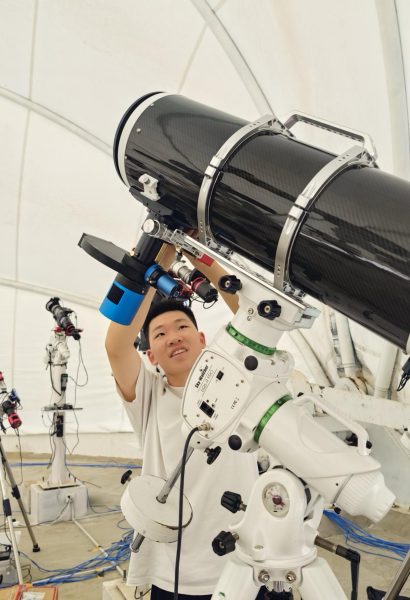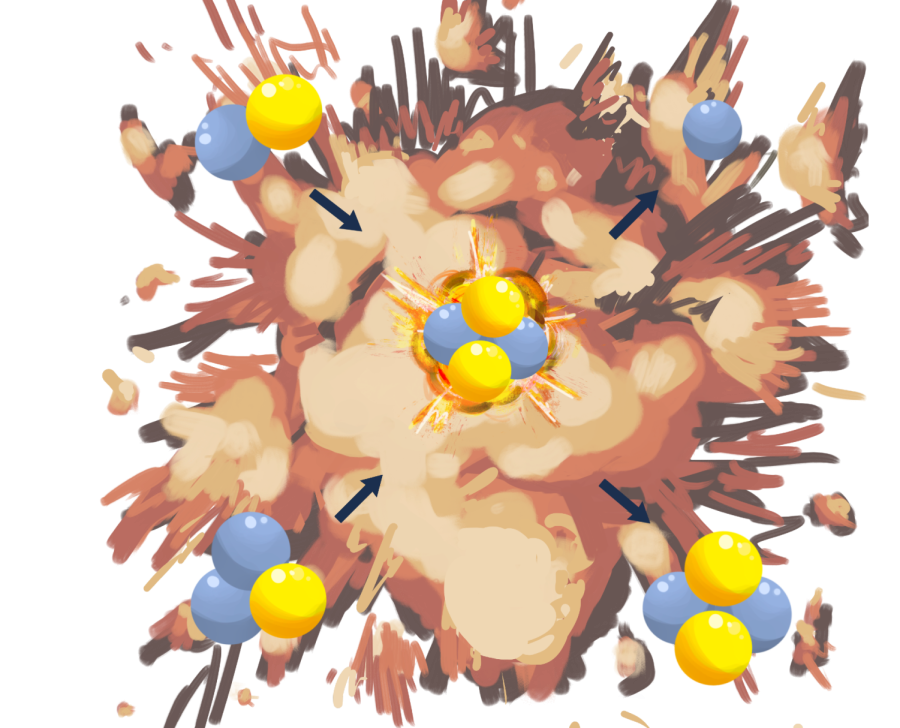Nuclear fusion: Powering a brighter future
Fusion breakthrough opens doors to a new renewable energy source
An illustration representing the process of nuclear fusion. In December, researchers completed the first nuclear fusion experiment yielding an energy surplus.
It begins with a single pulse of light.
The pulse first separates into 192 separate beams, amplified and adjusted so their power distribution is even while traveling a distance of one and a half kilometers. They converge upon a pea-sized pellet of hydrogen encased in an almost perfectly-spherical shell. When every beam strikes the target at the exact same time, the temperature of the pellet surges to over 100 million degrees Celsius, and the hydrogen atoms merge with each other, forming helium and releasing a small burst of energy.
Although scientists have repeated this experiment numerous times, researchers 30 miles away from Harker at the National Ignition Facility (NIF) in Livermore, California completed an iteration of the experiment that released approximately 3.15 megajoules, surpassing the 2.05 megajoules of energy that researchers used to power the contraption. For the first time in history, a nuclear fusion reaction created within a laboratory yielded an increase in total energy. Currently, the amount of energy is too small to prove useful, but in the future, the energy could heat water and generate electricity.
Nuclear fusion is the process by which two lighter atoms fuse to form a heavier atom. This process is the opposite of nuclear fission, the much better-known process that drives nuclear power today. In fission, a neutron strikes a heavy atom, most commonly uranium or plutonium, and splits the atom into two smaller atoms, releasing energy. However, fusion is more potent: when the two atoms fuse, the resulting nucleus contains less mass than the original nuclei. The remaining mass becomes pure energy, as per Albert Einstein’s famous equation E = mc2. This released energy exceeds the energy produced by fission four times.
“[Nuclear fusion] is one of the very few processes that we know about nature in which matter is directly converted into energy,” said upper school physics teacher Dr. Mark Brada.
Although fusion has great potential to develop into an efficient and environmentally friendly energy source, scientists still face many challenges. In order to spark fusion, particles must travel at extremely high speeds, overcoming the repelling forces between protons among different nuclei and closing the distance between the two atoms to around 10-14 meters. Furthermore, the element used in the reaction must contain a minimal amount of protons, as a higher proton count necessitates a greater repelling force, which needs more energy to overcome. Therefore, researchers use hydrogen, which possesses only one proton in its nucleus, to produce the most efficient reaction.
“The maximum amount of energy that will come out will be from using light nuclei like hydrogen and helium,” upper school chemistry teacher Dr. Mala Raghavan said. “It’s much harder to fuse a higher number of protons [because] that will require much more energy.”
Performing fusion in the lab setting poses a difficulty in itself. Fusion occurs naturally in the sun, which releases the created energy as heat to warm our planet. However, the sun’s interior is extremely hot: the core can reach temperatures of up to 15 million degrees Celsius. But to fuse atoms, a lab must exceed these temperatures, as the immense pressure within the sun lowers the required temperature. Thus, researchers must use extremely precise lasers: if they are mistimed by even a fraction of a second, the pellet will not reach the desired temperature, and no fusion occurs.
“All of these beams have to arrive at [one] point at exactly the same time,” Dr. Raghavan said. “If they don’t come at the same time, then you’ve lost. That was the engineering marvel, where they had to have all 192 lasers go through many tubes to amplify, and then finally converge on that little spot on the casing.”
Due to these challenges, nuclear fusion still remains infeasible for commercial energy production, and it will likely stay that way for many years to come. The inertial-based fusion reactor at Lawrence Livermore laboratory cost around $3.5 billion to construct, a hefty price tag for a megajoule of energy. To be commercially viable, scientists must be able to use fusion on a much larger scale and much more cheaply.
“The reality is that the amount of energy that they produced was about enough to heat up one cup of coffee, so we’re not talking about a giant amount of energy,” Dr. Brada said. “Right now they can fire the [reaction] twice a day. It’s like we can heat up two cups of coffee a day. That’s nice and all, but not really useful, so we are still decades away from the point where this is going to be something that’s going to be useful as a commercially viable operation.”
Rather, the breakthrough serves as a proof of concept, encouraging scientists to further research and develop the field. Besides the Lawrence NIF laboratory, other associations are also using different methods to perform nuclear fusion. One such megaproject is the International Thermonuclear Experimental Reactor (ITER), a collaboration between 35 countries around the world, including the U.S. Unlike the methods used in the NIF laboratory, the ITER tokamak machine, located in southern France and currently under construction, utilizes an alternative approach known as magnetic confinement. The contraption consists of a donut-shaped tube, known as a toroidal field coil, looped around a central solenoid, a collection of niobium-tin coils charged with electrical current. The structure, resembling a massive electromagnet, generates strong magnetic fields that trap the plasma within the tube, effectively forcing particles together to initiate fusion.
Scientists hope that in the long term, humanity can use nuclear fusion as an efficient and sustainable source of energy. Unlike fission, fusion produces no nuclear waste and does not damage the environment in any way. Additionally, society can sustain nuclear fusion for much longer than traditional sources of energy like coal and natural gas and even other sources of renewable energy like solar energy and nuclear fission. The oceans contain many tons of deuterium, and current research around nuclear fusion looks for ways to generate tritium.
“[Solar and wind] energy is very effective and cheap, but there are concerns that there may be less solar energy during the winter and at other times there may be less wind energy,” Green Team Treasurer Shreyas Chakravarty (10) said. “They’re not perfectly reliable and we cannot base our grid 100% off them. [Nuclear fusion] has a really high cost, but it’s incredibly reliable and safe.”

Victor Gong (12) is an Editor-in-Chief for the Winged Post, and this is his fourth year on staff. This year, he hopes to experiment with unique page designs,...

Andrew Liang (11) is the co-news editor for Harker Aquila and the Winged Post, and this is his third year on staff. This year, Andrew wishes to consistently...

Yifan Li (12) is an Editor-in-Chief of the TALON Yearbook, and this is her fourth year on staff. This year, she hopes to further explore creative and unique...


















![“[Building nerf blasters] became this outlet of creativity for me that hasn't been matched by anything else. The process [of] making a build complete to your desire is such a painstakingly difficult process, but I've had to learn from [the skills needed from] soldering to proper painting. There's so many different options for everything, if you think about it, it exists. The best part is [that] if it doesn't exist, you can build it yourself," Ishaan Parate said.](https://harkeraquila.com/wp-content/uploads/2022/08/DSC_8149-900x604.jpg)




![“When I came into high school, I was ready to be a follower. But DECA was a game changer for me. It helped me overcome my fear of public speaking, and it's played such a major role in who I've become today. To be able to successfully lead a chapter of 150 students, an officer team and be one of the upperclassmen I once really admired is something I'm [really] proud of,” Anvitha Tummala ('21) said.](https://harkeraquila.com/wp-content/uploads/2021/07/Screen-Shot-2021-07-25-at-9.50.05-AM-900x594.png)







![“I think getting up in the morning and having a sense of purpose [is exciting]. I think without a certain amount of drive, life is kind of obsolete and mundane, and I think having that every single day is what makes each day unique and kind of makes life exciting,” Neymika Jain (12) said.](https://harkeraquila.com/wp-content/uploads/2017/06/Screen-Shot-2017-06-03-at-4.54.16-PM.png)








![“My slogan is ‘slow feet, don’t eat, and I’m hungry.’ You need to run fast to get where you are–you aren't going to get those championships if you aren't fast,” Angel Cervantes (12) said. “I want to do well in school on my tests and in track and win championships for my team. I live by that, [and] I can do that anywhere: in the classroom or on the field.”](https://harkeraquila.com/wp-content/uploads/2018/06/DSC5146-900x601.jpg)
![“[Volleyball has] taught me how to fall correctly, and another thing it taught is that you don’t have to be the best at something to be good at it. If you just hit the ball in a smart way, then it still scores points and you’re good at it. You could be a background player and still make a much bigger impact on the team than you would think,” Anya Gert (’20) said.](https://harkeraquila.com/wp-content/uploads/2020/06/AnnaGert_JinTuan_HoHPhotoEdited-600x900.jpeg)

![“I'm not nearly there yet, but [my confidence has] definitely been getting better since I was pretty shy and timid coming into Harker my freshman year. I know that there's a lot of people that are really confident in what they do, and I really admire them. Everyone's so driven and that has really pushed me to kind of try to find my own place in high school and be more confident,” Alyssa Huang (’20) said.](https://harkeraquila.com/wp-content/uploads/2020/06/AlyssaHuang_EmilyChen_HoHPhoto-900x749.jpeg)








